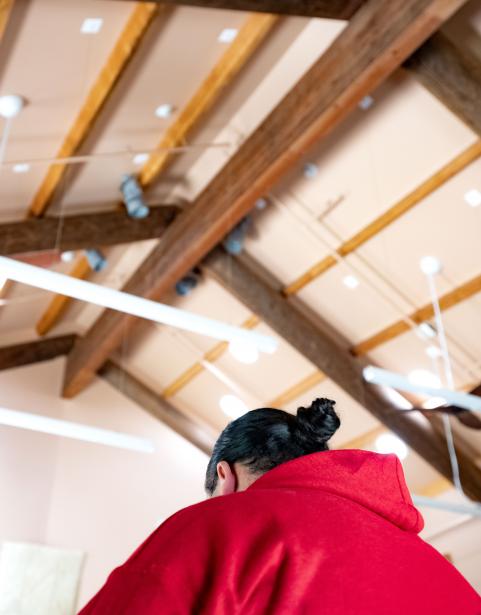Taylor Henry is a Coast Salish Weaver from the Tulalip Tribe. Henry has been weaving for eight years. He practices all aspects of Coast Salish Weaving, including spinning, material gathering, natural dyes, and weaving. His work is created primarily for ceremonial purposes. Producing weavings for Tribal elders, naming ceremonies, weddings, newborn welcoming’s, and memorials. He views his practice as a continuation of an art form that has been sleeping for eighty years in his family. This drove him to push the boundaries of his artistic practice, which began with sewing, beading, and cedar weaving that culminated in his work with wool.
Excerpts from a conversation between the artist Taylor Henry and the curator on September 12th, 2002
Tell me about this work.
I wanted to try twine and twill together, but I wanted it to be like a dancing shall. I wanted it to be the shape of a Chilkat blanket. So, it was very specific on how I wanted it, as far as the shape of the Chilkat with the pointed bottom. And I wanted to try all of the elements of Coast Salish Weaving. The diamonds, triangles, squares, zig-zag, the water design, they’re all in it.
I’ve done two dancing shawls before this one, but they are very different. This one challenged me to combine the twine and twill together.
How do you find the state of mind to step up to the loom? How do you find time for weaving?
It's more of a–I have to be at the loom. To keep myself in check. To keep sane. Just forgetting everything else that’s going on and being present right then and there at the loom.
What would you say to someone who was interested in getting into weaving and has never done anything like that before, someone who is perhaps not culturally engaged?
I do believe it's a gift, and not everybody can do it. Same with almost anything as far as a traditional craft, if you want to call it a craft. I think that if you are a weaver and you want to do weaving it's more than a want and it speaks to you and you can’t think of nothing else but weaving. And you can’t go to bed until you weave, or you lay in bed and your mind just goes to spinning. So, you got to get up and spin–two minutes just to be able to go back to bed. It can consume you in a way, that I guess is healthy consumption. So just be open to that commitment.
What is it like to create a blanket for a ceremonial purpose?
When somebody asks me to make something, for anything, I always ask them what it's for. So, I know what to pray for even though you’re constantly praying when you’re doing weaving. I always try to because a lot of the time I know the person. If it's for a memorial, naming, anything really. If I don’t know the person, I know the family. We can all relate to the loss of somebody. Losing somebody close to you or somebody that is getting a name it’s a huge thing. I want to know the purpose of the work so I can pray for the work and that that day goes smoothly. It helps the family when they see the woven piece for whatever it's being used for. That they know that it's for that person. I don’t know, I can’t really put it into words yet, but it's the honor of somebody asking you to– and I’m speaking from a memorial perspective, It’s the last thing we can do for a person, so its huge honor that they’ve thought of you, let alone ask you to weave for them.

